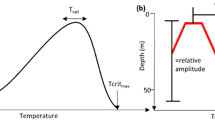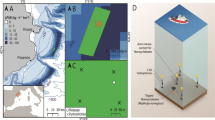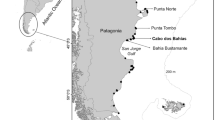Abstract
The horizontal and vertical movements of large bigeye tuna (Thunnus obesus Lowe, 1839; 25 to 50 kg) captured in the south Pacific Ocean (French Polynesia) were determined using pressure-sensitive ultrasonic transmitters. Bigeye tuna swam within the first 100 m below the surface during the night-time and at depths between 400 and 500 m during the daytime. The fish exhibited clear relationships with the sound scattering layer (SSL). They followed its vertical movements at dawn and dusk, and were probably foraging on the organisms of the SSL. Bigeye tuna did, however, make regular rapid upward vertical excursions into the warm surface layer, most probably in order to regulate body temperature and, perhaps, to compensate for an accumulated oxygen debt (i.e. to metabolize lactate). The characteristics of these dives differ from those reported from previous studies on smaller bigeye tuna (∼12 kg) near the main Hawaiian Islands. During the daytime, the large fish in French Polynesia made upward excursions approximately only every 2.5 h, whereas smaller fish in Hawaiian waters made upward excursions approximately every hour. Our data are the first observations on the role of body size in the vertical behavior of bigeye tuna.
Similar content being viewed by others
Author information
Authors and Affiliations
Additional information
Received: 9 September 1998 / Accepted: 25 November 1999
Rights and permissions
About this article
Cite this article
Dagorn, L., Bach, P. & Josse, E. Movement patterns of large bigeye tuna (Thunnus obesus) in the open ocean, determined using ultrasonic telemetry. Marine Biology 136, 361–371 (2000). https://doi.org/10.1007/s002270050694
Issue Date:
DOI: https://doi.org/10.1007/s002270050694




